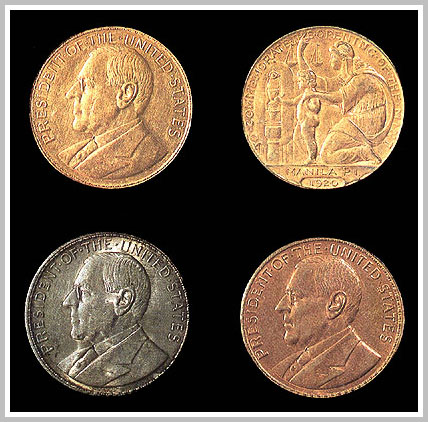

|
|
|
|
|
|
|
|
|
1903 - 1935 
Top row shows the obverse and reverse of the extremely rare gold "Wilson Dollar". Below are the silver and bronze counterparts of the same piece. All three medals (38 mm) are in top-rate uncirculated condition, among the best in the world. |
| Through the
1903 Coinage Act, the United States government established a gold-based
monetary system in the Philippines, but it was not until 1920 that coins
were actually minted in the Philippines under this authority. Through all
this time, Philippine coins had been produced in San Francisco (mint mark
S) and Philadelphia (no mint mark) and shipped to Manila. In response to
the growing need for local coinage, the Manila Mint was opened on July
15, 1920 and, in order to commemorate this historic event, a set of medals
was struck.
Designed by Clifford Hewitt, the WILSON MEDAL (38 mm, plain edge) was struck in bronze (mintage 3,700), silver (mintage 2,200) and gold (five reported) but, being a commemorative, was never intended for circulation or use as money (note that there are no monetary values indicated). Although technically a medal, it has been considered a commemorative coin and dubbed the "WILSON DOLLAR" by collectors. The obverse bears the legend "PRESIDENT OF THE UNITED STATES" with the bust of President Woodrow Wilson facing left, while the reverse bears the legend "TO COMMEMORATE THE OPENING OF THE MINT/MANILA, P.l./1920" with allegorical figures of mother and child presumably referring to the then-special relationship between the United States of America and the Philippines respectively. Among all of these “coins”, the gold piece is of course the most valued by collectors not so much for its intrinsic worth but because of its EXTREMELY LIMITED mintage. It is said that there were actually more than five gold specimens minted, but to date no actual count has been established and the specimen featured here in both obverse and reverse) together with the impeccable silver and bronze pieces, is EXTREMELY RARE and one of the best, if not the best in the world. (Set from a Philippine collection) |
|
|
|
|